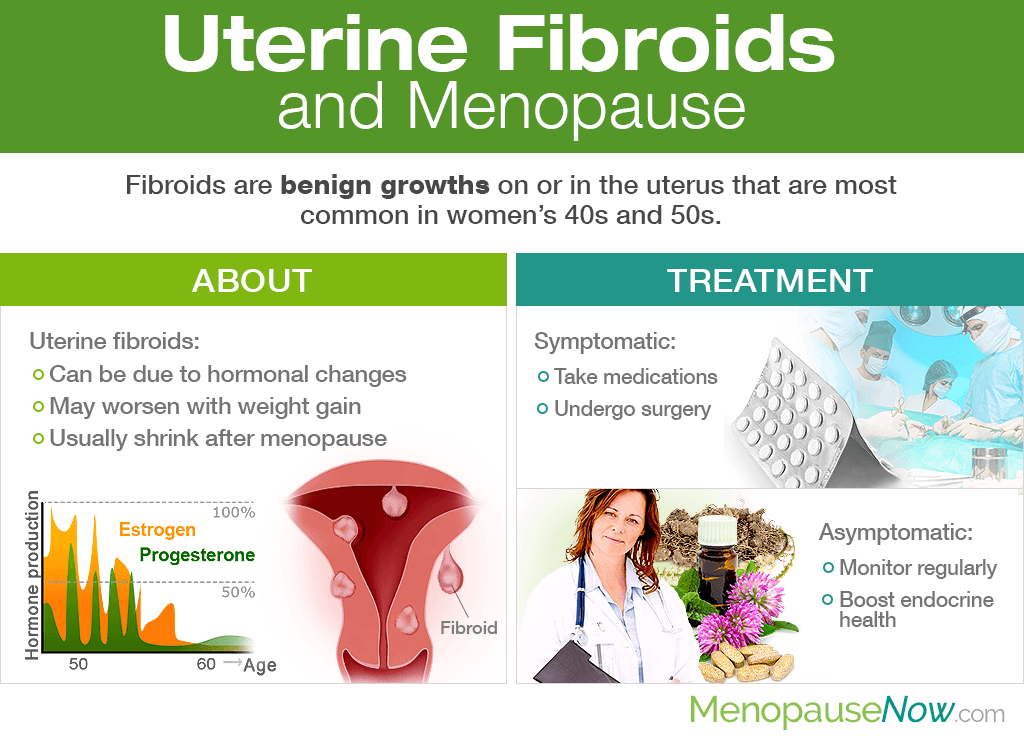Similar to ovarian cysts during menopause, uterine fibroids are extremely common to develop as women transition throughout their reproductive years, emerging in the lifetimes of up to 80 percent of them. However, not everyone will develop symptoms nor require treatment.
Continue reading to learn about fibroids and menopause for a greater understanding of this condition and better clarity over your reproductive health.
About Uterine Fibroids
Also referred to as leiomyomas or myomas, uterine fibroids are growths on or in the uterus that vary in size. They are almost always benign, meaning they don't develop into cancer.
Uterine fibroids normally do not cause symptoms and are most often found during a routine pelvic exam. When they do cause symptoms, these can include heavy vaginal bleeding; pelvic discomfort; lower back or leg pains; bladder issues, like frequent urination; and pain with sexual intercourse, among others.
The exact cause of uterine fibroids is unknown; however, researchers contribute their occurrence to the reproductive hormones estrogen and progesterone; genetic changes; or other growth factors, which include substances that help the body maintain tissues, like insulin-like growth factor.
Uterine Fibroids and Menopause

The presence or growth of uterine fibroids can bring varying concerns for women depending on if they happen during the menopausal transition or afterwards.
Uterine Fibroids during Menopause
Uterine fibroids are most common in women in their 40s and 50s, right around the time they are passing through the menopause transition.
As such, the appearance of fibroids during perimenopause can be attributed to the drastic hormonal fluctuations taking place in women's bodies as their ovaries wind down reproductive function, although similar to premenopausal women, the exact cause is unknown.
Furthermore, women are more susceptible to risk factors during this time that can heighten their chances of developing fibroids, including weight gain and age. Fibroids become more common as women age, and women who are overweight are at a greater risk for developing these uterine growths as well.
Uterine Fibroids after Menopause
Because the development of fibroids is largely dependent upon hormones, they usually shrink after menopause due to a decrease in hormone production. Nevertheless, if fibroids are causing symptoms or growing after menopause, women should consult their doctors immediately for appropriate treatment.
Treating Uterine Fibroids During and After Menopause
Treating uterine fibroids during and after a woman's reproductive years will depend upon if they are symptomatic.
Symptomatic Uterine Fibroids

Women who are suffering from mild uterine fibroid symptoms may be recommended to take medications for the pain - like acetaminophen - or iron supplements for heavy bleeding. Other drugs used to treat symptoms of fibroids include birth control, nonsteroidal anti-inflammatory drugs (NSAIDs), and gonadotropin releasing hormone (Gn-RH) agonists.
Whereas, women who have moderate or severe symptoms may be encouraged to undergo surgical procedures of a myomectomy, which removes the fibroids without damaging the uterus; hysterectomy to remove the uterus; or endometrial ablation, which is when the uterine lining is removed to control very heavy bleeding, among others.
Discuss each treatment option with your healthcare provider in depth before finalizing your decision.
Asymptomatic Uterine Fibroids

For women who exhibit minimal or no symptoms, “watchful waiting” - also called expectant management - may be the best course of action. As such, to keep track of any concerning changes, women will be evaluated periodically by their doctors.
However, because their presence is oftentimes an indication of hormonal imbalance, women with fibroids during menopause or with postmenopausal fibroids are encouraged to treat the underlying cause.
As such, pursuing non-invasive menopause symptoms treatments would support optimal endocrine system health. In this way, women will not only directly address their fibroids, but also find ultimate relief from other perimenopause symptoms, such as hot flashes, night sweats, low libido, mood swings, and more.
Sources
- Mayo Clinic. (2018). Uterine fibroids: Symptoms & causes | Diagnosis & causes. Retrieved May 28, 2019, from https://www.mayoclinic.org/diseases-conditions/uterine-fibroids/symptoms-causes/syc-20354288 | https://www.mayoclinic.org/diseases-conditions/uterine-fibroids/diagnosis-treatment/drc-20354294
- Office on Women's Health. (2019). Uterine fibroids. Retrieved May 28, 2019, from https://www.womenshealth.gov/a-z-topics/uterine-fibroids
- Shrestha, R. et al. (2015). Fibroid degeneration in a postmenopausal woman presenting as an acute abdomen. Journal of Community Hospital Internal Medicine Perspectives, 5(1). doi: 10.3402/jchimp.v5.25917
- UCLA Health. (n.d.). What are Fibroids | Treatment Options: Watchful Waiting. Retrieved May 28, 2019, from https://www.uclahealth.org/fibroids/what-are-fibroids | https://www.uclahealth.org/fibroids/watchful-waiting
- UCSF Health. (n.d.). Fibroids. Retrieved May 28, 2019, from https://www.ucsfhealth.org/conditions/fibroids/

